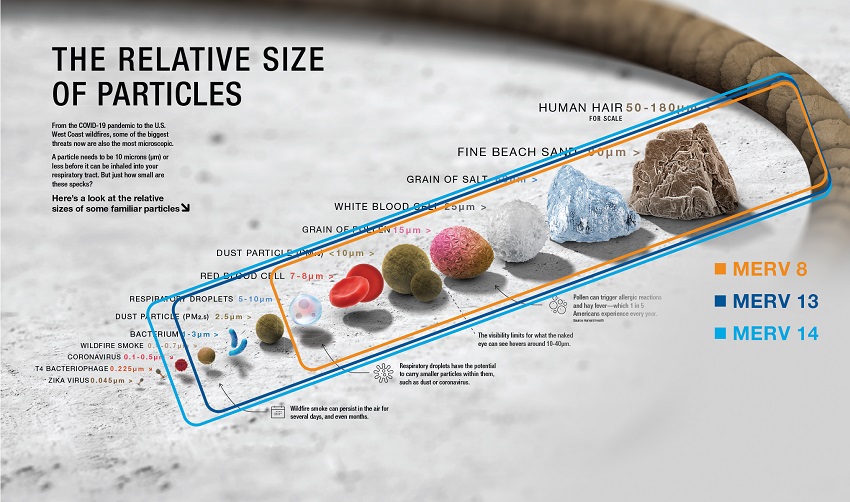What Are the Effects of Increasing Air Filtration Requirements on Fan Performance?

The Centers for Disease Control and Prevention have recently released guidance for improving air quality in buildings. In addition, the American Society of Heating, Refrigerating and Air-Conditioning Engineers (ASHRAE) has recently published ASHRAE Standard 241P, Control of Infectious Aerosols. These updates provide recommendations on how to improve indoor air cleanliness and include the use of MERV 13 filtration.
In California, MERV 13 filtration is required for supply air in many commercial buildings per California Building Standards Code Title 24. California maintains some of the strictest air quality requirements in the country due to concerns about pollution and public health.
What is a MERV rating?
Minimum Efficiency Reporting Value (MERV) is a rating system that measures the effectiveness of air filters. The higher the MERV rating, the more efficient the filter is at capturing airborne particles.
A MERV 13 filter is capable of capturing particles as small as 0.3 microns, including pollen, dust mites, mold spores, pet dander, and even some bacteria and viruses (Figure 1).
 |
| Figure 1: Particle Sizes Captured by Various Levels of MERV Filtration |
The Effect of Filtration on Fan Performance
When you increase your level of filtration (for example, you might move from a MERV 8 to a MERV 13 filter), the intent is to filter out additional airborne particles. Unfortunately, you don’t get additional filtration for free! The denser media, smaller pores, and other features of advanced filtration create more resistance to airflow. To maintain your desired flow rate, the fan will need to work harder. You’ll need to increase the fan speed to achieve the duty point, leading to higher power consumption and more noise!
Let’s expand on the ramifications of increased filtration:
- Reduced airflow: The increased resistance to flow (higher pressure drop) can impede the airflow through the filter, leading to decreased air circulation within the system. Reduced airflow can result in inadequate ventilation, compromised system performance, or insufficient cooling and/or heating in HVAC applications.
- Increased energy consumption: The fan needs to work harder to overcome the higher pressure drop, resulting in increased energy usage. This can lead to higher operational costs, especially in systems where fans operate continuously!
- Increased Noise: With an increase in fan speed, you will see an increase in the fan’s sound level. Depending on the application and installation, filtration may result in undesirable sound levels. Picture the scenario where an inline fan with filtration is installed near a lecture hall or an examination room…that’s not the location you want to produce excessive noise.
- Increased strain on the fan: The fan motor and blades experience additional stress when operating against a higher pressure drop. This may lead to increased wear and tear, decreased fan lifespan, and a higher likelihood of breakdowns or maintenance requirements.
It is essential to consider the impact of increased filter efficiency on fan performance when designing or operating systems. System designers may need to select fans with higher power capabilities, adjust fan speeds, or optimize the overall system design to ensure that the desired airflow rates are maintained without excessive strain on the fans.
To assure that you achieve the performance you expect, Greenheck provides the performance corrections associated with filtration on many products in both our Computer Aided Product Selection software (CAPS®) and eCAPS® engineer application suite. Filtration is an important part of many systems; Greenheck can help make sure it’s correctly accounted for!
KSQ Mixed Flow Supply Fan with MERV 13 Filtration
Greenheck incorporates MERV 13 filters in the design of several of our air movement products. Our new KSQ Mixed Flow Supply Fan is designed to work seamlessly with MERV 13 filters to provide maximum performance and efficiency for filtered roof supply and untempered make-up air systems. The KSQ comes standard with aluminum 1-inch filters but also offers an optional MERV 13 2-inch filter for applications requiring higher filter efficiencies. When using MERV 13 filters, the KSQ will still incorporate aluminum filters in front of the MERV 13 paper filters. To assure performance while minimizing risks associated with water reaching the MERV 13 filters, MERV 13 filtration on the KSQ is only available with bottom intake.
In addition to MERV 13 filtration, the KSQ fan offers a variety of features and benefits that make it the ideal choice for the supply of clean, outdoor air. Its mixed flow wheel improves airflow and efficiency while reducing sound and footprint while the totally enclosed motor eliminates the need for a motor cover and improves motor access. Vari-Green® motors are available through 10 hp that eliminate the need for additional controls (a dial-on-fan is standard). Multiple intake and discharge options, roof curbs and accessories, duct adapters, backdraft and control dampers, decorative and protective coatings, duct collars, isolation options, disconnect switches, and various control options are available.
If you're looking for high-performance ventilation solutions that can help improve indoor air quality while meeting or exceeding industry standards for MERV 13 filtration in California or other areas with strict air quality regulations, look no further than Greenheck!
For more information on the KSQ fan and other Greenheck products incorporating MERV filtration, contact your nearby Greenheck representative.
Fans


from